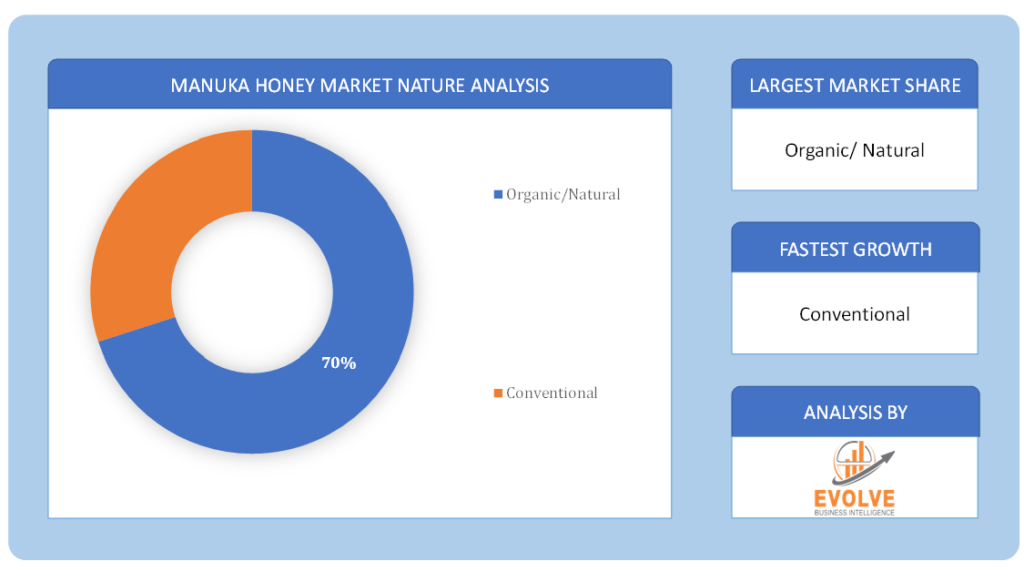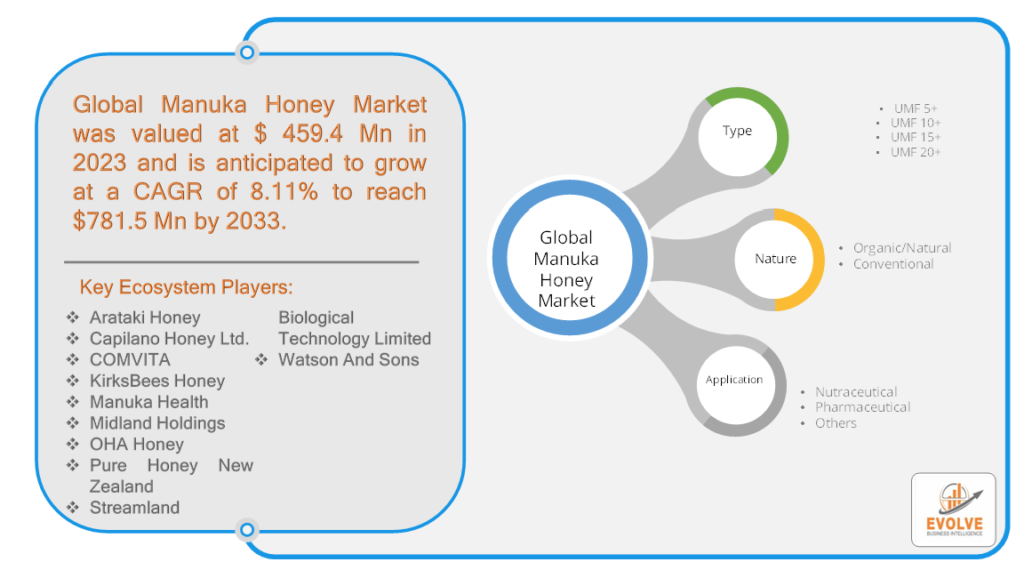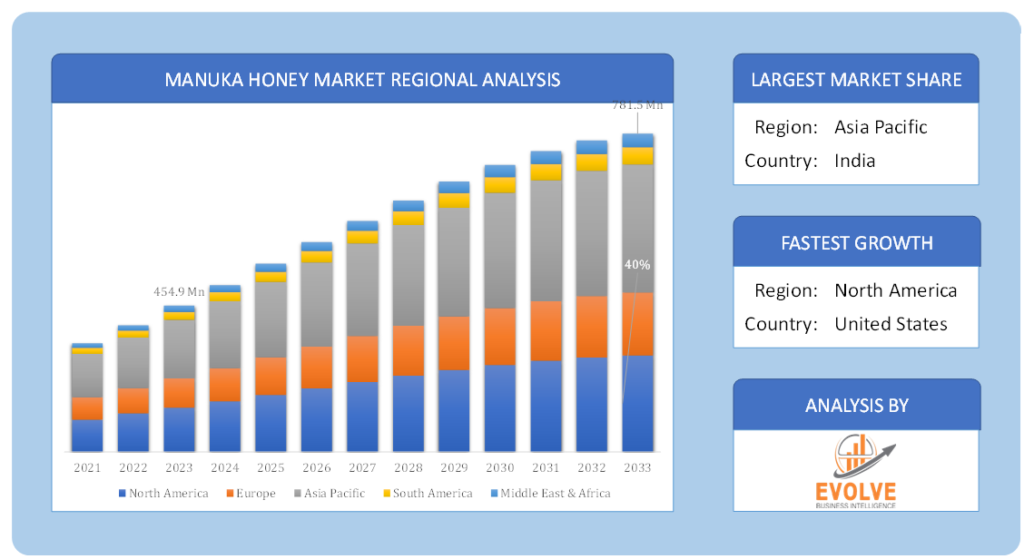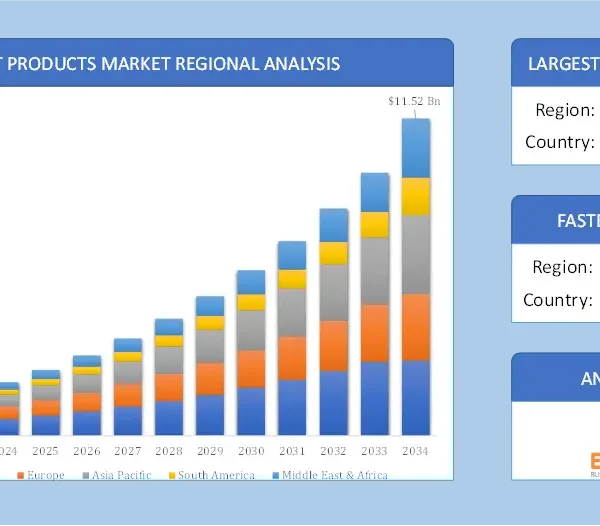Manuka Honey Market Overview
The global Manuka Honey Market Size is expected to reach USD 781.5 Million by 2033. The global Manuka Honey industry size accounted for USD 459.4 Million in 2023 and is expected to expand at a compound annual growth rate (CAGR) of 8.11% from 2023 to 2033. Manuka honey, derived from the nectar of the Manuka tree (Leptospermum scoparium), has gained significant attention in recent years for its unique properties and health benefits. It is primarily produced in New Zealand and parts of Australia, where the Manuka tree thrives. Manuka honey is known for its high antibacterial activity due to the presence of a compound called methylglyoxal (MGO). This natural product has been used for centuries in traditional medicine for its healing properties.
The uses and applications of Manuka honey are diverse. It is widely consumed as a natural sweetener and flavor enhancer in various food and beverage products. Moreover, its medicinal properties have led to its use in pharmaceuticals, nutraceuticals, and cosmetic products. Manuka honey is also used in wound care, as it exhibits antimicrobial and wound-healing properties. Its unique composition and potential health benefits have sparked interest among consumers seeking natural remedies and functional foods.
Global Manuka Honey Market Synopsis
The COVID-19 pandemic has had both positive and negative effects on the Manuka honey market. Initially, the market experienced disruptions due to supply chain constraints and logistical challenges caused by lockdowns and restrictions on international trade. The closure of retail outlets and limited access to distribution channels affected the sales of Manuka honey products. However, the pandemic also highlighted the importance of health and immunity, leading to a surge in demand for natural and immune-boosting products like Manuka honey.
As the world transitions into the post-COVID era, the Manuka honey market is expected to rebound and witness significant growth. Consumers’ heightened focus on personal health and wellness, coupled with the growing preference for natural remedies, will drive the demand for Manuka honey. Moreover, the expanding e-commerce sector and the shift towards online shopping have opened new avenues for product distribution and market reach. These factors, along with the resumption of global trade, are anticipated to contribute to the market’s recovery and expansion in the coming years.
Manuka Honey Market Dynamics
The major factors that have impacted the growth of Manuka Honey are as follows:
Drivers:
Ø Rising Consumer Awareness and Demand for Natural Remedies
The rising consumer awareness and demand for natural remedies have emerged as a key driving factor for the Manuka honey market. In the wake of the COVID-19 pandemic, individuals have become more conscious of their health and well-being. They are actively seeking natural alternatives to support their immune systems and overall vitality. Manuka honey, with its potent antibacterial properties and potential health benefits, has gained traction as a natural remedy.
Consumers are increasingly turning to Manuka honey for its perceived medicinal value. Its usage as a natural immune booster, digestive aid, and wound healer has garnered attention and trust among health-conscious individuals. Moreover, the organic and clean-label nature of Manuka honey appeals to those seeking natural and sustainable products. The growing body of scientific research supporting the health benefits of Manuka honey has further reinforced consumer confidence in its efficacy.
Restraint:
- Supply Chain Disruptions and Price Volatility
One of the restraining factors that impacted the Manuka honey market during the COVID-19 pandemic was the disruption in the supply chain and the subsequent price volatility. The global lockdowns and travel restrictions imposed to contain the spread of the virus led to logistical challenges and hindered the transportation of Manuka honey from production regions to consumers worldwide.
The closure of borders and limited access to international markets resulted in reduced export volumes of Manuka honey. This scarcity of supply created a supply-demand imbalance, leading to increased prices. The limited availability of Manuka honey products in retail outlets further exacerbated the price volatility. These fluctuations made it challenging for consumers to afford or maintain consistent consumption of Manuka honey.
Opportunity:
⮚ Growing Market Penetration and International Expansion
The post-COVID scenario presents significant opportunities for the Manuka honey market, particularly in terms of market penetration and international expansion. As consumer awareness about the health benefits of Manuka honey continues to increase, the market has the potential to reach a wider customer base and expand into new geographical regions.
The global market for natural and organic products is expanding rapidly, driven by the growing consumer preference for sustainable and clean-label options. Manuka honey, with its natural and organic attributes, is well-positioned to capitalize on this trend. The rising demand for functional foods and natural remedies provides an opportunity for manufacturers to develop innovative products that incorporate Manuka honey as a key ingredient.
Manuka HoneySegment Overview
By Type
Based on the Type, the market is segmented based on UMF 5+, UMF 10+, and UMF 15+. the UMF 15+ segment holds the largest share of the Manuka Honey market. UMF 15+ Manuka honey has a higher concentration of MGO, making it more potent in terms of its antimicrobial properties. This segment is favored by consumers seeking maximum health benefits and is often used in medicinal and therapeutic applications. The demand for UMF 15+ Manuka honey is driven by its reputation for high quality and effectiveness in promoting wound healing, supporting immune function, and improving overall well-being.
By Nature
 Based on Nature, the market has been divided into Organic/Natural, and Conventional, Consumer Goods, and Others. The Organic/Natural segment holds the largest share of the market. The organic/natural segment is witnessing significant growth due to the rising consumer preference for clean-label and sustainable products. Consumers perceive organic Manuka honey to be free from synthetic chemicals and pesticides, making it a healthier choice. The organic/natural segment is expected to gain market share as consumers prioritize products that align with their health and environmental concerns.
Based on Nature, the market has been divided into Organic/Natural, and Conventional, Consumer Goods, and Others. The Organic/Natural segment holds the largest share of the market. The organic/natural segment is witnessing significant growth due to the rising consumer preference for clean-label and sustainable products. Consumers perceive organic Manuka honey to be free from synthetic chemicals and pesticides, making it a healthier choice. The organic/natural segment is expected to gain market share as consumers prioritize products that align with their health and environmental concerns.
Based on Application, the market has been divided into Nutraceutical, Pharmaceutical, and Others. The nutraceutical segment holds a substantial share in the market. Manuka honey is increasingly used in nutraceutical products due to its nutritional value and potential health benefits. It is incorporated into dietary supplements, functional foods, and beverages to provide natural sweetness and additional health-promoting properties.
Global Manuka Honey Market Regional Analysis
Based on region, the global Logistics Intelligence Software market has been divided into North America, Europe, Asia-Pacific, South America and Middle East & Africa. North America is projected to dominate the use of the market followed by the Europe and Asia-Pacific regions.
 Manuka Honey Market Analysis North America
Manuka Honey Market Analysis North America
North America is a prominent market for Manuka honey, driven by the increasing consumer awareness of its health benefits and rising demand for natural remedies. The United States, in particular, has witnessed a surge in the consumption of Manuka honey due to its growing popularity as a functional food ingredient and natural sweetener. The presence of a well-established health and wellness industry, coupled with a large consumer base seeking clean-label products, contributes to the market growth in this region.
Manuka Honey Asia Pacific MarketAnalysis
Asia Pacific is another key region for the Manuka honey market. Countries like China, Japan, and Australia have witnessed a significant rise in the consumption of Manuka honey. The increasing disposable incomes, changing dietary preferences, and growing health-consciousness among consumers in the region have fueled the demand for natural and organic products. Moreover, the traditional use of honey in Asian cultures as a medicinal ingredient has further boosted the market growth. The expanding e-commerce sector and the presence of a large population provide ample opportunities for market expansion in this region.
Competitive Landscape
The global Manuka Honey market is highly competitive, with numerous players offering a wide range of software solutions. The competitive landscape is characterized by the presence of established companies, as well as emerging startups and niche players. To increase their market position and attract a wide consumer base, the businesses are employing various strategies, such as product launches, and strategic alliances.
Manuka Honey Market Prominent Players:
- Arataki Honey
- Capilano Honey Ltd.
- COMVITA
- KirksBees Honey
- Manuka Health
- Midland Holdings
- OHA Honey
- Pure Honey New Zealand
- Streamland Biological Technology Limited
- Watson And Sons.
Key Development:
March 2023: Manuka Health, made a significant development 2023. The company announced the launch of a new line of Manuka honey-based skincare products. This expansion into the skincare segment demonstrates Manuka Health’s commitment to diversifying its product offerings and tapping into the growing demand for natural and organic skincare solutions.
Scope of the Manuka Honey Market Report
Global Manuka Honey Market, by Type
- UMF 5+
- UMF 10+
- UMF 15+
Global Manuka Honey Market, by Nature
- Organic/Natural
- Conventional
Global Manuka Honey Market, by Application
- Nutraceutical
- Pharmaceutical
- Others
Global Manuka Honey Market, by Region
- North America
- US
- Canada
- Mexico
- Europe
- UK
- Germany
- France
- Italy
- Spain
- Benelux
- Nordic
- Rest of Europe
- Asia Pacific
- China
- Japan
- South Korea
- Indonesia
- Austalia
- Malaysia
- India
- Rest of Asia Pacific
- South America
- Brazil
- Argentina
- Rest of SouthAmerica
- Middle East &Africa
- Saudi Arabia
- UAE
- Egypt
- SouthAfrica
- Rest of Middle East & Africa
| Parameters | Indicators |
|---|---|
| Market Size | 2033: $781.5 Million |
| CAGR | 8.11% CAGR (2023-2033) |
| Base year | 2022 |
| Forecast Period | 2023-2033 |
| Historical Data | 2021 |
| Report Coverage | Revenue Forecast, Competitive Landscape, Growth Factors, and Trends |
| Key Segmentations | Type,Nature, Application |
| Geographies Covered | North America, Europe, Asia-Pacific, Latin America, Middle East, Africa |
| Key Vendors | Arataki Honey, Capilano Honey Ltd., COMVITA, KirksBees Honey, Manuka Health, Midland Holdings, OHA Honey, Pure Honey New Zealand, Streamland Biological Technology Limited, and Watson And Sons |
| Key Market Opportunities | Growing Market Penetration and International Expansion |
| Key Market Drivers | Rising Consumer Awareness and Demand for Natural Remedies |
REPORT CONTENT BRIEF:
- High-level analysis of the current and future Manuka Honey market trends and opportunities
- Detailed analysis of current market drivers, restraining factors, and opportunities in the future
- Manuka Honey market historical market size for the year 2021, and forecast from 2023 to 2033
- Manuka Honey market share analysis at each product level
- Competitor analysis with a detailed insight into its product segment, Conventional strength, and strategies adopted.
- Identifies key strategies adopted including product launches and developments, mergers and acquisitions, joint ventures, collaborations, and partnerships as well as funding taken and investment done, among others.
- To identify and understand the various factors involved in the global Manuka Honey market affected by the pandemic
- To provide a detailed insight into the major companies operating in the market. The profiling will include the Conventional health of the company’s past 2-3 years with segmental and regional revenue breakup, product offering, recent developments, SWOT analysis, and key strategies.










